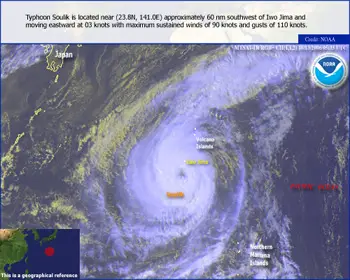Did you know that cyclones are actually the release of stored solar energy. The sun heats the surface of the ocean and this creates the condition for these storms to develop and these storms spin because the Earth is spinning. This rotation is clockwise in the southern hemisphere, and counter-clockwise in the northern hemisphere. It’s due to something called the coriolis effect.
The IPCC 4th Report shows that intense tropical cyclone (TC) activity has increased since about 1970, with a larger increase in numbers and proportion of hurricanes reaching categories 4 and 5. The total number of TCs and TC days has decreased slightly, although Brazil recorded its first ever in March 2004. (You can see reports on recent severe tropical cyclones here).

The earth’s rotation also imparts an acceleration and this acceleration causes these storm systems to turn towards the poles in the absence of strong steering currents. Thus, in the Northern Hemisphere these commonly move west in the beginning, normally turn north (and are then usually blown east), and ones in the Southern Hemisphere are deflected south, if no strong pressure systems are counteracting the Coriolis acceleration.
The Coriolis acceleration also initiates the rotation, but it is not the driving force that brings this rotation to high speeds. These speeds are due to the conservation of angular momentum – air is drawn in from an area much larger than the storm such that the tiny rotational speed (originally imparted by the Coriolis acceleration) is magnified greatly as the air is drawn in to the low pressure center.
On 20 March 2006, TC Larry a Category 5 hit Australia on the Far North Queensland coast just south of Cairns. While there was no loss of life, a significant number of homes and businesses in the area were affected and the area was declared a natural disaster zone by the Queensland Government.
At landfall, the eye of Larry extended about 20 to 25 kilometres from Mirriwinni in the north to Mourilyan Harbour in the south. A vessel sheltering in the South Johnstone River to the east of Innisfail recorded winds gusting to 225 km/h while gusts as high as 294 km/h were recorded near the peaks of the Bellenden Ker mountain range. Recovery cost were said to exceed AU$1.5 billion.
Below is an animated sequence of TC Monica which formed off the northeastern coast of Australia on April 17, 2006. This is the same general area where Larry formed a month earlier. Monica was well away from most settled areas, limiting the damage it was predicted to cause.
